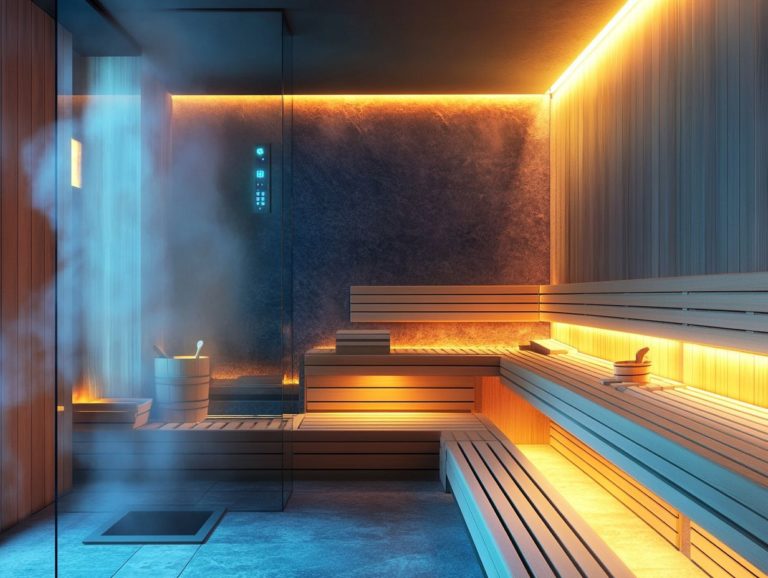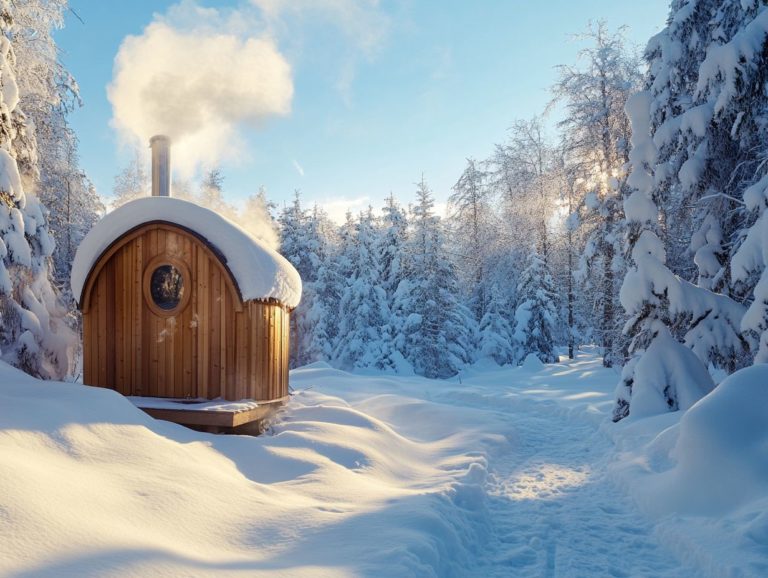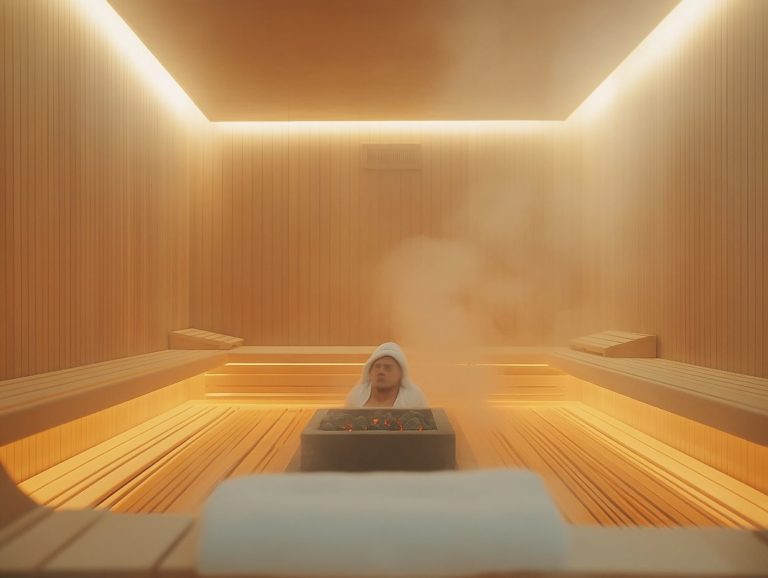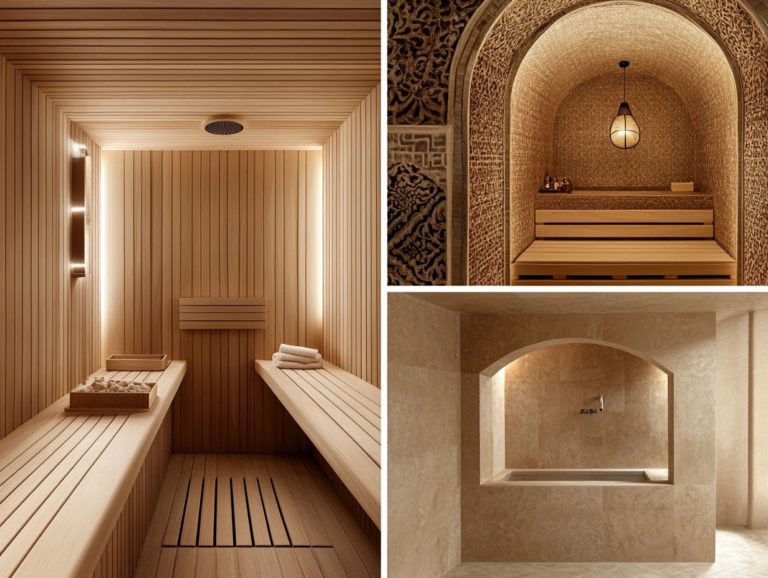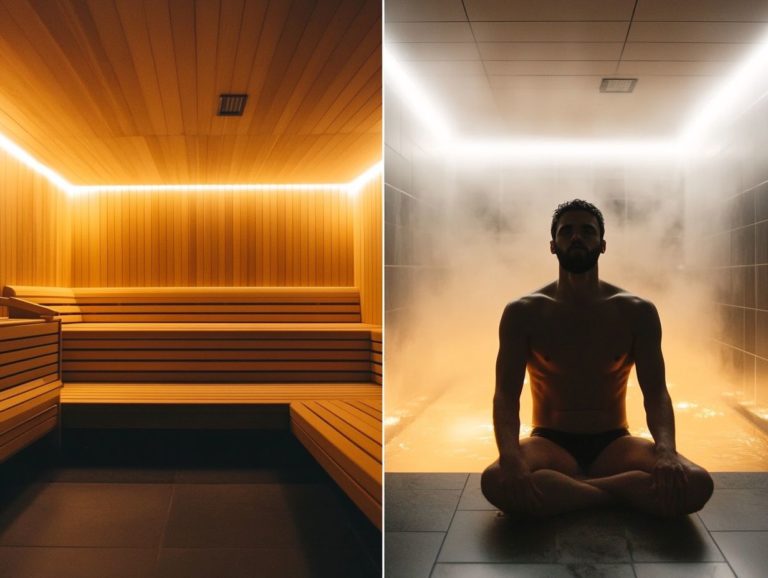Sauna Cost Comparison: Which Type to Choose?
Are you contemplating adding a sauna to your home or wellness routine? With a variety of saunas available, each offering unique benefits and experiences, the selection process can feel overwhelming.
This article explores ten popular sauna types, including installation costs and essential factors to consider.
Dive into the health benefits, energy efficiency, and safety precautions that empower you to make a well-informed choice tailored to your lifestyle and budget.
Contents
- Key Takeaways:
- 1. Traditional Sauna
- 2. Infrared Sauna
- 3. Steam Sauna
- 4. Portable Sauna
- 5. Outdoor Sauna
- 6. Electric Heater Sauna
- 7. Wood Burning Sauna
- 8. Gas Heater Sauna
- 9. Pellet Sauna
- 10. How Much Does a Sauna Cost?
- Frequently Asked Questions
- What are the different types of saunas available for cost comparison?
- How much does a traditional steam sauna typically cost?
- What is the average cost of an infrared sauna?
- Are outdoor saunas more expensive than indoor saunas?
- Are there any ongoing maintenance costs for saunas?
- Which type of sauna is the most cost-effective?
Key Takeaways:
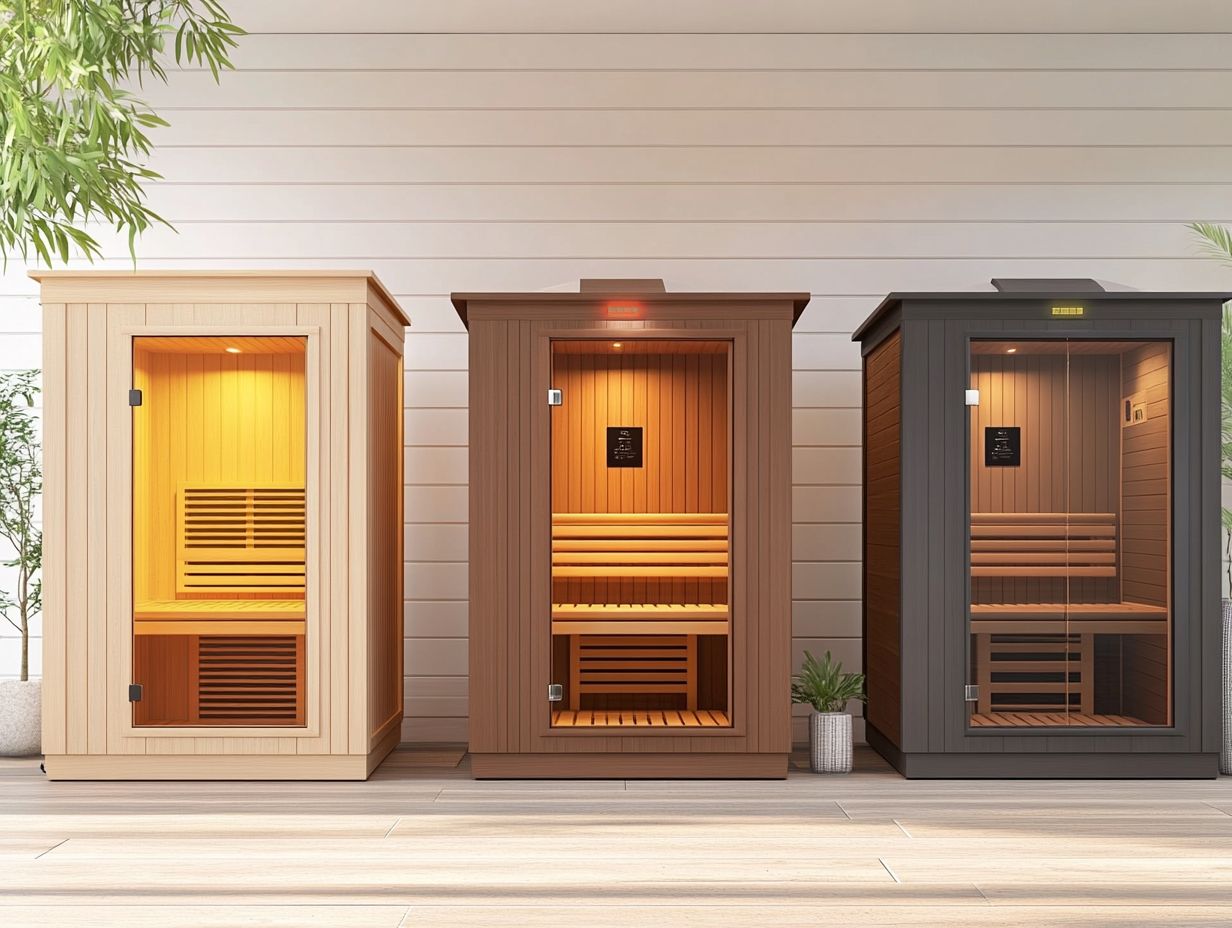
- Choose traditional saunas for affordability and common use, but remember they need regular maintenance.
- Opt for infrared saunas for an energy-efficient and gentle heat experience.
- Consider steam saunas for their excellent respiratory health benefits, keeping in mind potential installation costs.
1. Traditional Sauna
The traditional sauna, rich in history and cultural significance, offers a unique experience that seamlessly blends relaxation with an array of health benefits. It s a favored choice for those looking to enhance muscle recovery and alleviate stress in a tranquil setting.
Constructed from natural materials like cedar, it promises an authentic sauna experience that prioritizes both comfort and wellness. The delightful aroma and warmth of cedar elevate the ambiance and add to the sauna’s longevity. You’ll need a dedicated space of at least four to six feet wide to ensure optimal airflow and comfort during your sessions.
Planning the installation involves careful consideration, including proper insulation and ventilation for consistent heating. Regular sauna use can unlock numerous health benefits, from improved circulation to effective detoxification, while significantly reducing stress levels.
It s essential to observe important safety precautions, such as staying hydrated and monitoring your time inside to prevent overheating, ensuring a genuinely rejuvenating experience.
2. Infrared Sauna
Infrared saunas utilize cutting-edge technology to deliver heat directly to your body, offering a unique experience that unlocks a plethora of benefits, including enhanced muscle recovery, improved circulation, and energy efficiency. They re quickly becoming the go-to choice for home sauna enthusiasts.
Unlike traditional saunas that warm the air around you, infrared saunas use infrared panels devices that emit heat directly to your body. This results in a more intense sweat at lower temperatures, creating a comfortable experience that allows for longer sessions without overwhelming heat.
This makes it easier for you to enjoy health benefits such as detoxification and skin rejuvenation. These compact saunas fit perfectly in small spaces, making home relaxation easier than ever.
3. Steam Sauna
Steam saunas, with their inviting moist heat, offer an unparalleled rejuvenating experience that enhances your wellness routine. They provide remarkable health benefits, including stress relief, improved skin conditions, and respiratory support.
These saunas generate steam through a sophisticated water heating system, creating a humid atmosphere that deeply penetrates your skin and opens up your pores. Typically crafted from durable materials like cedar or hemlock, steam saunas not only promise durability but also impart a soothing aroma that elevates the experience.
With features like adjustable humidity levels and built-in seating, your therapeutic journey is enhanced. Many users relish the detoxifying effects of regular sessions, which can also boost circulation and ease joint pain.
Whether placed indoors or outdoors, these versatile structures can effortlessly transform any space into your personal sanctuary for relaxation and rejuvenation.
4. Portable Sauna
Portable saunas offer you a flexible and convenient solution for your wellness journey. You can indulge in the health benefits of steam or infrared heat wherever you are. They re ideal for those with limited space or a lifestyle that demands frequent travel.
These innovative saunas come in a variety of designs think pop-up tents, foldable steam cabinets, and portable infrared models. Each option is tailored to fit your unique preferences. You ll find key features like adjustable temperature settings, built-in timers, and simple setup options. This makes them incredibly user-friendly for individuals of all ages.
Unlike traditional saunas that require dedicated space and a hefty investment, portable versions present an affordable alternative. You can easily store or transport them. The advantages go beyond mere convenience; you can access the therapeutic benefits of heat therapy without the hassle or cost of a gym membership, all from the comfort of your home or while you re on the move.
5. Outdoor Sauna
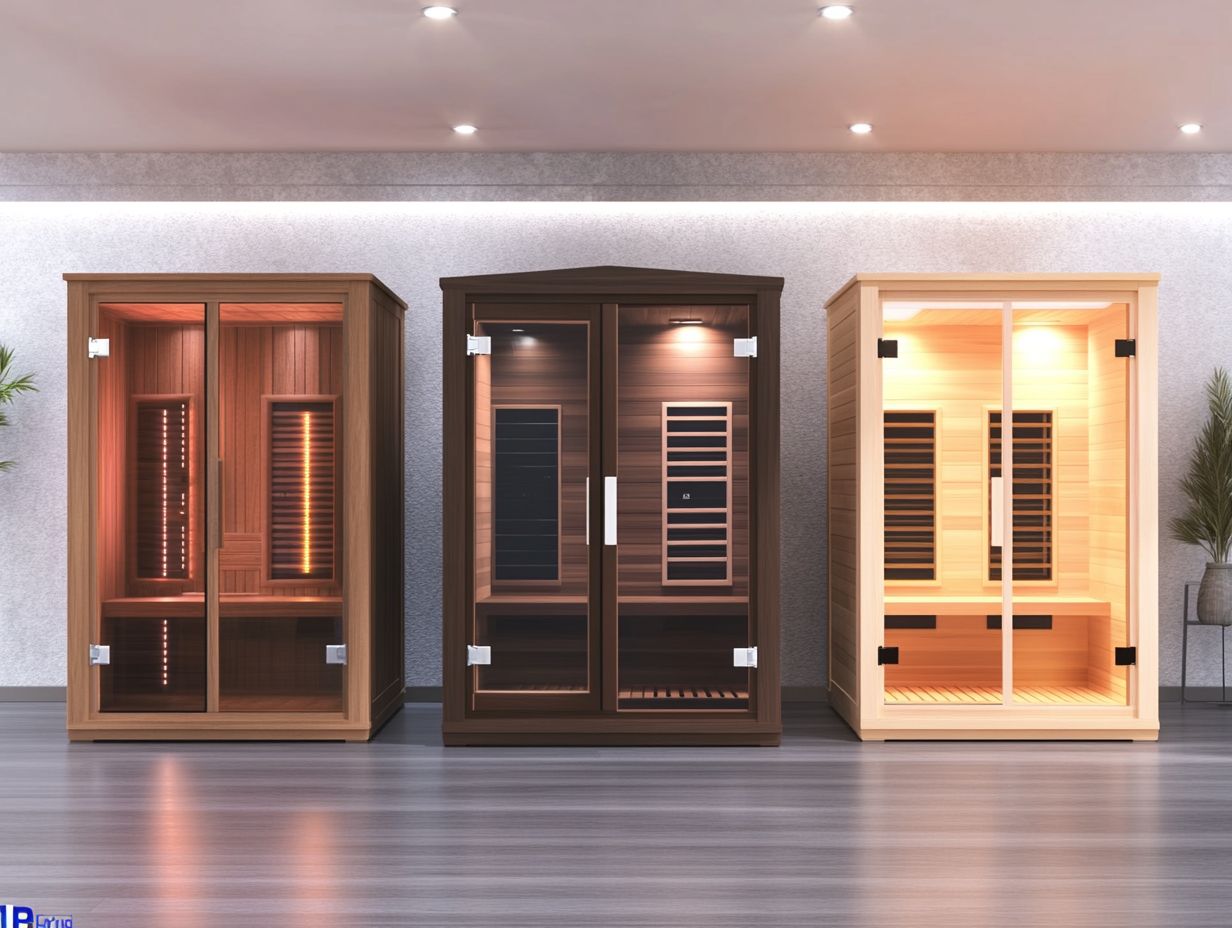
An outdoor sauna not only enhances your home s aesthetic appeal, but it also immerses you in nature. You can enjoy relaxation and health benefits throughout the year, whether you opt for a traditional style or a sleek modern prefab design.
These distinctive structures come in various designs, from rustic log cabins to minimalist models. You can choose one that harmonizes beautifully with your landscape. Materials such as cedar, redwood, and thermally modified wood are popular picks, known for their resistance to decay and ability to withstand diverse weather conditions, ensuring longevity.
The installation process is quite straightforward and can often be wrapped up in just a few days, especially with modular units (pre-assembled components that simplify setup). By strategically placing an outdoor sauna in your backyard, you create a soothing retreat and elevate your property s overall aesthetics, transforming an ordinary space into an extraordinary haven for relaxation.
6. Electric Heater Sauna
Electric heater saunas offer you a hassle-free and efficient way to enjoy the soothing benefits of heat therapy. With consistent temperatures and easy installation, it’s no wonder they ve become a favorite for modern home sauna experiences.
These innovative saunas are designed with your convenience in mind. They feature intuitive controls that let you effortlessly adjust settings for a truly personalized experience. Unlike traditional wood-burning methods that demand meticulous preparation, electric saunas provide rapid warmth and require significantly less maintenance. Their energy efficiency means lower utility bills, making them an eco-friendly choice for those who prioritize health and sustainability.
The installation process is remarkably straightforward; often, all you need is an electrical outlet. In no time, you can transform any space into your own serene retreat, free from the headaches associated with conventional heating sources.
7. Wood Burning Sauna
A wood burning sauna offers you an authentic experience. It embraces traditional heating methods that elevate the overall sauna journey with a distinct aroma, warmth, and a deep connection to nature. It s no wonder so many sauna enthusiasts hold it in high regard.
These unique saunas often showcase traditional materials like cedar, spruce, or pine. Not only are these woods durable, but they also release delightful scents when heated, enhancing your relaxation.
The installation process can be quite rewarding, requiring thoughtful planning and careful attention to safety precautions. It s essential to ensure proper ventilation and adhere to local regulations to minimize any fire risks.
When you indulge in this experience, you may find yourself forming a genuine emotional bond with your wood burning sauna. It transforms into a peaceful retreat from the hustle and bustle of daily life. This fosters a sense of community and well-being, creating shared moments of relaxation that you ll cherish.
8. Gas Heater Sauna
Gas heater saunas present a practical alternative to traditional wood-burning and electric models. They deliver consistent heat with enhanced efficiency, making them an appealing choice for anyone seeking to blend comfort with modern technology.
By utilizing natural gas or propane, you can enjoy the luxurious feel of a sauna right at home! Unlike other heating methods, they require less ongoing maintenance. Their user-friendly interface allows for quick temperature adjustments, minimizing those pesky waiting times.
Gas heaters are engineered for optimal efficiency, leading to lower operational costs over time compared to electric saunas, which often consume more energy.
The installation process for gas heater saunas is generally straightforward and requires only proper ventilation and gas line connections. This simplicity makes them easier to install than electric models, which often involve complex wiring and additional electrical work.
9. Pellet Sauna
Pellet saunas offer a modern way to heat your sauna, using wood pellets to create a sustainable and efficient solution. They cater to environmentally conscious individuals while delivering the same health benefits as traditional saunas.
By integrating modern technology, these saunas significantly reduce carbon emissions, aligning seamlessly with today s ecological values. Their energy efficiency is particularly impressive, thanks to easy-to-set heat levels that minimize heat loss and maximize comfort.
With their sleek designs, pellet saunas effortlessly complement a variety of home aesthetics, making them a stylish addition to both indoor and outdoor spaces.
When considering installation, assess the available space and choose durable materials that promise longevity. Proper ventilation and easy access to power sources are vital for optimal functionality, ensuring you can fully indulge in the rejuvenating experience that pellet saunas provide.
10. How Much Does a Sauna Cost?
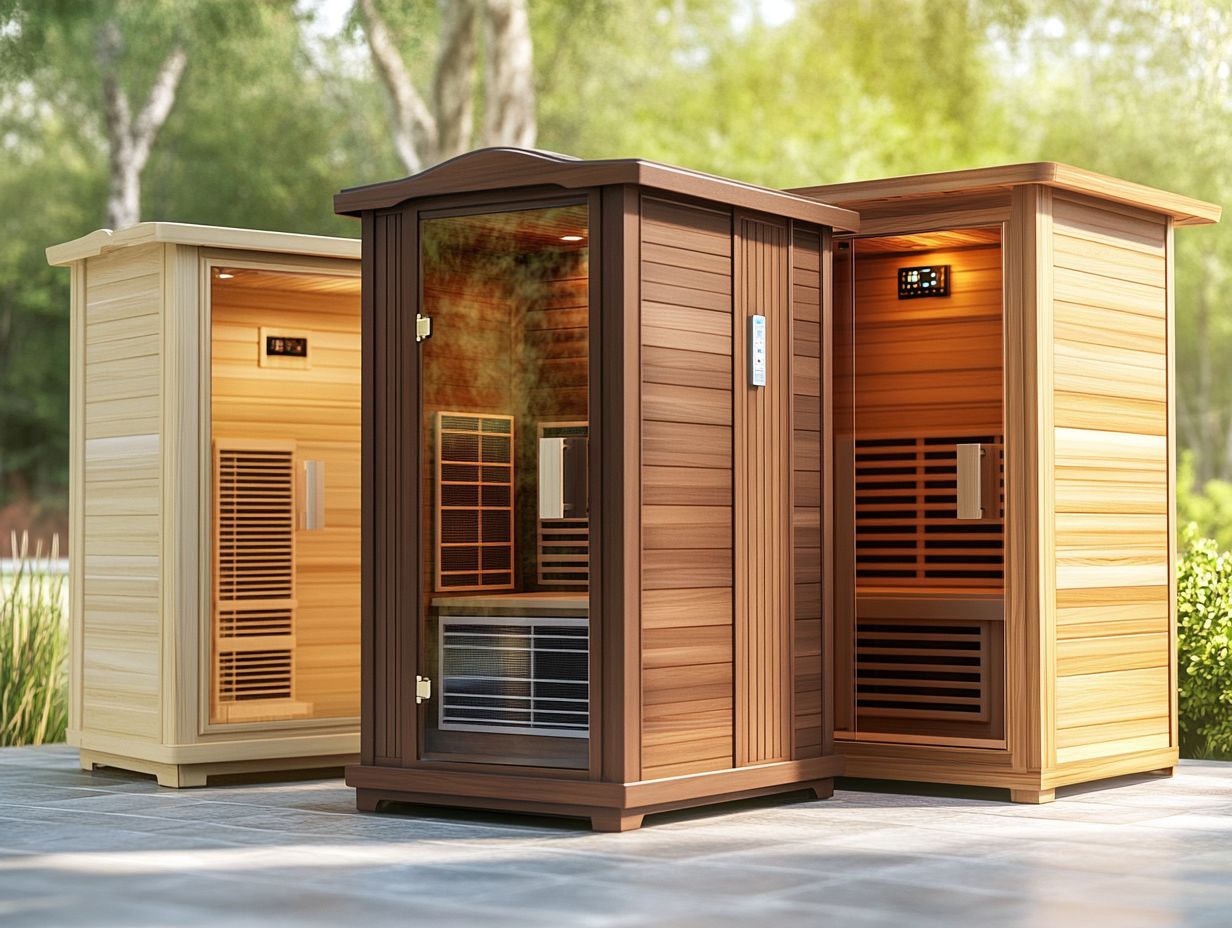
The cost of purchasing and installing a sauna can vary widely based on several factors, including the type of sauna, the materials used, and the complexities of installation. Understanding these elements is crucial for making a well-informed investment that aligns with your budget and space requirements.
Typically, you ll find that initial pricing differs significantly between traditional wood-fired options and modern infrared models, each boasting its own unique materials and designs. For example, opting for high-quality cedar may lead to a higher upfront expense compared to more standard materials.
Installation fees can also come into play, especially for electrical units that may require professional assistance. While these initial costs might appear overwhelming, consider the potential long-term benefits: improved health and relaxation, reduced utility bills thanks to energy efficiency, and even an increase in property value.
Ultimately, investing in a sauna now can lead to better health and relaxation today, elevating your personal wellness while also proving financially advantageous in the long run.
What Are the Factors Affecting the Cost of a Sauna?
Several critical factors influence the overall cost of your sauna, including the type of sauna you choose, the materials selected, the custom features you desire, and the complexities involved in installation. All of these contribute to the final costs for your home sauna.
Your choice between traditional steam saunas and modern infrared options can significantly affect pricing. Infrared models often require less energy and installation effort, making them a more budget-friendly option.
The materials you select for construction, such as cedar or hemlock, vary in price and durability, impacting both the aesthetics and longevity of your sauna.
If you’re considering custom features like integrated lighting or sound systems, keep in mind that while they can enhance your experience, they will also add to the overall expense. Labor costs for installation can fluctuate based on the complexity of your project, including any necessary plumbing or electrical work, which involves installing or upgrading water and electrical systems.
Custom designs can come with higher costs due to the individual craftsmanship involved, making careful planning essential as you create your personalized retreat.
What Are the Maintenance Costs for Different Types of Saunas?
Maintenance costs for saunas vary significantly based on the type, materials, and frequency of use. Understanding these factors is crucial to ensure both longevity and satisfaction with your sauna experience.
For example, infrared saunas usually require less upkeep due to their simpler design and fewer components, which translates to lower overall maintenance expenses. In contrast, traditional saunas need a more hands-on maintenance routine, including regular inspections of heating elements and wood surfaces, potentially leading to higher costs.
Steam saunas also demand diligent care to prevent mold and mineral buildup, especially in humid environments. By prioritizing energy efficiency, you not only reduce immediate expenses but also mitigate long-term operational costs. This approach creates a more sustainable experience and ensures that your investment remains sound for years to come.
What Are the Health Benefits of Using a Sauna?
Using a sauna offers a wealth of health benefits, including stress relief, enhanced muscle recovery, improved circulation, and detoxification. These advantages make it an invaluable addition to your wellness routine and a prime example of sauna therapy, which involves using heat to promote overall health.
The soothing heat of the sauna works wonders for relaxation by lowering cortisol levels, cultivating a profound sense of calm. In this tranquil setting, you can escape daily stressors and promote your mental health.
Enhanced muscle recovery is aided by increased blood flow, delivering essential nutrients to fatigued muscles and helping you bounce back more quickly post-exercise. Scientific studies demonstrate that regular sauna sessions can bolster cardiovascular health by improving circulation and lowering blood pressure.
The intense sweating during a sauna session plays a pivotal role in detoxification, aiding in the elimination of heavy metals and toxins from your body. This process boosts your overall well-being and enhances your vitality.
Which Type of Sauna Is More Energy Efficient?
When considering energy efficiency, you’ll find that different sauna types offer varying levels of performance. Infrared saunas are often regarded as more energy efficient than traditional and electric models, making them a favored choice for those who prioritize the environment.
This efficiency arises from the way infrared models heat the body directly rather than warming the air, allowing for quicker warm-up times and lower overall energy consumption. Electric saunas, while still popular, typically demand more energy to maintain elevated temperatures, leading to higher running costs. This distinction impacts your immediate usage expenses and carries long-term costs.
Over time, opting for the energy-efficient infrared option can lead to substantial savings on electricity bills, making it an enticing investment for anyone looking to blend wellness with sustainability.
Essential Safety Tips for Your Sauna Experience
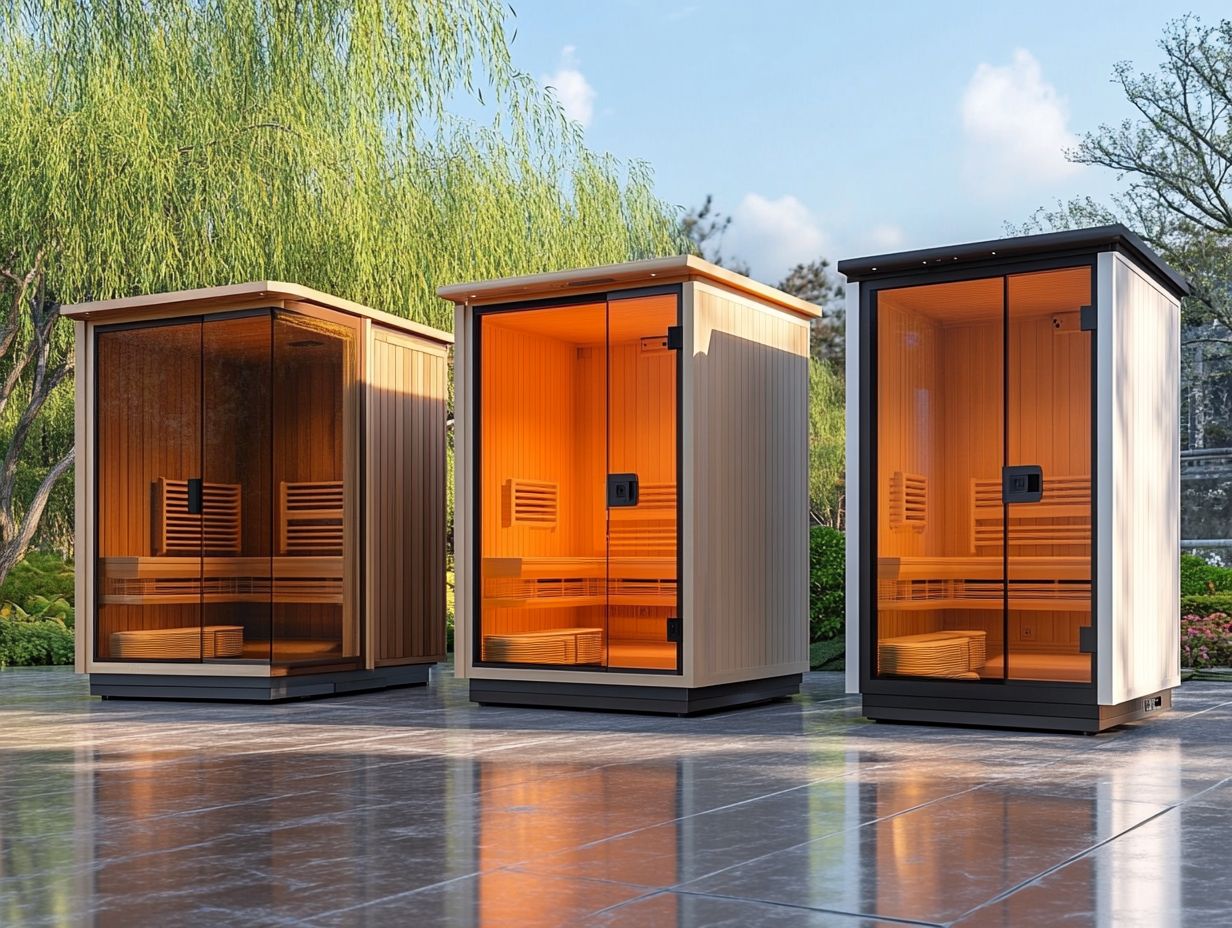
Ensuring your safety while using a sauna is essential. Grasping the sauna environment, recognizing your personal health conditions, and following recommended practices can elevate your sauna experience and minimize potential health risks.
To truly indulge in this relaxing ritual, prioritize hydration before you step inside. Drink plenty of water to counterbalance the fluid loss that comes with sweating. Keep your sauna sessions to a manageable 15-20 minutes to avoid overheating, allowing your body to acclimate gradually. Always pay attention to how you’re feeling while in the sauna if you start feeling discomfort or notice any signs of heat exhaustion, don t hesitate to step outside and cool off.
Proper installation of the sauna is also vital for maintaining a safe environment. Well-fitted equipment reduces the risks associated with electrical hazards and ensures everything functions optimally, allowing you to focus on relaxation without worry.
Frequently Asked Questions
What are the different types of saunas available for cost comparison?
There are three main types of saunas: traditional steam saunas, infrared saunas, and outdoor saunas. Each type has its own unique features and cost considerations.
How much does a traditional steam sauna typically cost?
The cost of a traditional steam sauna can range from $3,000 to $6,000, depending on the materials used, size, and additional features such as lighting and seating incorporated into the sauna design.
What is the average cost of an infrared sauna?
The average cost of an infrared sauna is between $1,500 and $5,000. This type of sauna uses infrared heaters to heat the body directly, making it a more energy-efficient option.
Are outdoor saunas more expensive than indoor saunas?
Outdoor saunas tend to be more expensive than indoor saunas due to the additional materials and construction required to make them weather-proof. The cost can range from $5,000 to $10,000.
Are there any ongoing maintenance costs for saunas?
Yes, saunas do incur ongoing maintenance costs, such as cleaning and replacing heating elements. These costs are generally low and vary by sauna type and usage frequency.
Which type of sauna is the most cost-effective?
The most cost-effective sauna type depends on your needs. Infrared saunas are usually more energy-efficient and have lower upfront costs. In contrast, traditional steam saunas may need more maintenance but offer a more authentic experience.

